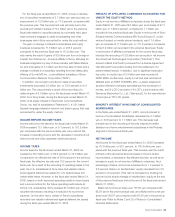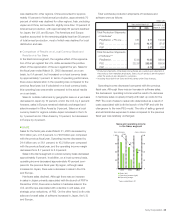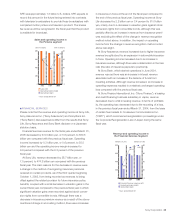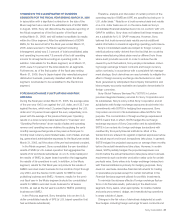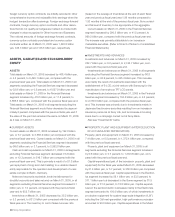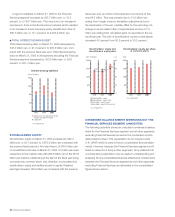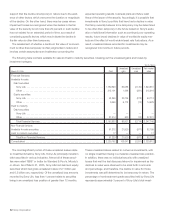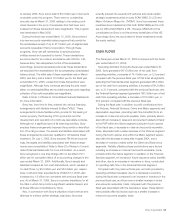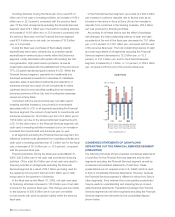Sony 2005 Annual Report Download - page 50
Download and view the complete annual report
Please find page 50 of the 2005 Sony annual report below. You can navigate through the pages in the report by either clicking on the pages listed below, or by using the keyword search tool below to find specific information within the annual report.Sony Corporation 47
CHANGES IN THE CLASSIFICATION OF BUSINESS
SEGMENTS FOR THE FISCAL YEAR ENDING MARCH 31, 2006
In association with a significant contraction in the size of the
Music segment as a result of the establishment of SONY BMG
in August, 2004, Sony will discontinue the separate reporting of
the Music segment as of the first quarter of the fiscal year
ending March 31, 2006, and will instead consolidate its results
within the Other segment. After the establishment of SONY
BMG, for the second half of the fiscal year ended March 31,
2005, sales revenue for the Music segment (including
intersegment sales) was 2.3 percent of total consolidated sales
and operating income was 7.9 percent of the total operating
income for all segments recording an operating profit. In
addition, total assets for the Music segment, as of March 31,
2005, were 3.5 percent of the total assets for all segments.
Furthermore, as of the first quarter of the fiscal year ending
March 31, 2006, Sony’s Japan-based disc manufacturing and
distribution business, previously classified within the Music
segment, is scheduled to be reclassified to the Electronics
segment.
FOREIGN EXCHANGE FLUCTUATIONS AND RISK
HEDGING
During the fiscal year ended March 31, 2005, the average value
of the yen was 106.5 yen against the U.S. dollar, and 133.7 yen
against the euro, which was 5.2 percent higher against the U.S.
dollar and 1.9 percent lower against the euro, respectively, com-
pared with the average of the previous fiscal year. Operating
results on a local currency basis described in “Overview” and
“Operating Performance” show results of sales and operating
revenue and operating income obtained by applying the yen’s
monthly average exchange rate in the previous fiscal year to
monthly local currency-denominated sales, cost of sales, and sell-
ing, general and administrative expenses for the fiscal year ended
March 31, 2005, as if the value of the yen had remained constant.
In the Music segment, Sony consolidates the yen-translated
results of SMEI (a U.S.-based operation that aggregates the
results of its worldwide subsidiaries on a U.S. dollar basis) and
the results of SMEJ (a Japan based operation that aggregates
the results of its operations in yen). In addition, in the Music
segment, results for this fiscal year only include the results of
SMEI’s recorded music business for the months of April through
July 2004, and the twelve month results for SMEI’s music
publishing business and SMEJ. However, results for the previ-
ous fiscal year in the Music segment include the consolidated
results for SMEI’s recorded music business for all twelve
months, as well as the full year’s results for SMEI’s publishing
business and SMEJ.
In the Pictures segment, Sony translates into yen the U.S.
dollar consolidated results of SPE (a U.S. based operation that
has worldwide subsidiaries).
Therefore, analysis and discussion of certain portions of the
operating results of SMEI and SPE are specified as being on “a
U.S. dollar basis.” Results on a local currency basis and results
on a U.S. dollar basis are not on the same basis as Sony’s
consolidated financial statements and do not conform with U.S.
GAAP. In addition, Sony does not believe that these measures
are a substitute for U.S. GAAP measures. However, Sony
believes that local currency basis results provide additional
useful information to investors regarding operating performance.
Sony’s consolidated results are subject to foreign currency
rate fluctuations mainly derived from the fact that the countries
where manufacturing takes place may be different from those
where such products are sold. In order to reduce the risk
caused by such fluctuations, Sony employs derivatives, includ-
ing foreign exchange forward contracts and foreign currency
option contracts, in accordance with a consistent risk manage-
ment strategy. Such derivatives are used primarily to mitigate the
effect of foreign currency exchange rate fluctuations on cash
flows generated by anticipated intercompany transactions and
intercompany accounts receivable and payable denominated in
foreign currencies.
Sony Global Treasury Services Plc (“SGTS”) in London
provides integrated treasury services for Sony Corporation and
its subsidiaries. Sony’s policy is that Sony Corporation and all
subsidiaries with foreign exchange exposures should enter into
commitments with SGTS for hedging their exposures. Sony
Corporation and most of its subsidiaries utilize SGTS for this
purpose. The concentration of foreign exchange exposures at
SGTS means that, in effect, SGTS hedges the net foreign
exchange exposure of Sony Corporation and its subsidiaries.
SGTS in turn enters into foreign exchange transactions with
creditworthy third-party financial institutions. Most of the
transactions are entered into against projected exposures before
the actual export and import transactions take place. In general,
SGTS hedges the projected exposures on average three months
before the actual transactions take place. However, in certain
cases, SGTS partially hedges the projected exposures one
month before the actual transactions take place when business
requirements such as shorter production-sales cycle for certain
products arise. Sony enters into foreign exchange transactions
with financial institutions primarily for hedging purposes. Sony
does not use these derivative financial instruments for trading
or speculative purposes except for certain derivatives in the
Financial Services segment utilized for portfolio investments.
To minimize the adverse effects of foreign exchange fluctua-
tions on its financial results, particularly in the Electronics
segment, Sony seeks, when appropriate, to localize material
and parts procurement, design, and manufacturing operations
in areas outside of Japan.
Changes in the fair value of derivatives designated as cash
flow hedges, including foreign exchange forward contracts and
BH6/30 Adobe PageMaker 6.0J /PPC




